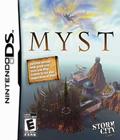Myst is a PC puzzle game released by long-defunct, as a proper publisher, Brøderbund in the early '90s. In game years, that's eons ago. If you've had anything to do with games for so far back, you likely recall Myst as "The game I couldn't quit playing," or, if it wasn't your thing, if you actually owned a PC, you probably shared that "personal" computer, and you'll remember the title as "Oh, please, would quit playing that game so I can use the computer." "Use the computer" for what I can't recall, though most likely typing a letter, for although computer scientist Tim Berners-Lee had invented the World Wide Web years before, the stunning innovation had barely just started to smoke, let alone catch fire. DOOM wouldn't even be released for a couple of months. Yet before PC gaming had become a real phenomenon, Myst was a PC game phenomenon.
More accurately, at the outset Myst was an Apple Macintosh PC game phenomenon, as although a Windows 3.1 version was released, shortcoming of Windows PCs in the audio department made the early Windows version of Myst less immersive, engrossing and slower to catch on. Myst was the fantasy of brothers Rand and Robyn Miller, and their software company, Cyan. The brothers Miller are perhaps best described as renaissance men, exceptional at many disciplines, which no doubt lead to the success of Myst, but they were not foremost computer programmers. Therefore, Myst for Macintosh was developed using Apple's HyperCard, software that was far better suited to prototyping than commercial release. HyperCard programs ran interpreted as opposed to compiled, which meant more steps removed from the central processing power of the computer and equaled slower and more contentious performance.
There was then no true HyperCard analog for Windows, indeed never really has been; creating an early Windows version of Myst was troubled, requiring various compromises. Still, Myst became the best-selling PC game ever, capturing a lot of the much-sought-after non-gamer market, and it remained king until juggernaut The Sims dethroned it not so very long after the latter game's 2000 release. Myst, however, may well remain the first "gaming phenomenon" that fairly fit criteria for phenomena. It was a huge title, spawned a fleet of sequels, ports and spin-offs, and its cultural influence extends to this day, as a creator of the groundbreaking, once wildly popular "Lost" television series pronounces Myst one of his inspirations in creating the overarching plot for the broadcast drama program.
Why all this history for the release of yet another version of Myst, this time for Nintendo DS, from Empire Publishing? Because Myst for DS producer Manny Granillo promises to bring the entirety of the original Myst title — and it's not brief; it's massive, by any gaming standard of any period — to DS, including a playable version of "The Rime Age," envisioned by the brothers Miller and referenced in the original Myst PC game, but not therein included as an interactive environment. Myst's art has been refined and restored for the DS version, as well as all the original audio remastered; don't expect the kinds of cornering-cutting in this version for Nintendo's tiny, flagship handheld as was long ago required for the first Windows edition of the game.
You would think — I certainly did, having been around for Myst's debut — the game's release on DS was foremost structured to leverage the casual-gamer demographic associated with the handheld. After all, although Myst was certainly played by plenty of men, young and old, it was well known as a "girlfriend game," the one video game you could actually get your girlfriend to play — and then, much to your chagrin, not stop playing so you could shoot something. Or perhaps, I thought, it's the DS interface. Myst used the PC mouse to move the cursor over "hot spots," discovering clues to solving all the game's secrets, and the "point-and-tap" DS interface is suited to replicating the PC controls. However, Granillo deserves much due credit in his approach to reproduce this title for a new market; although he admits DS diversity doesn't hurt and the handheld's interface is a good match, his primary interest in DS for a full release of Myst is the console's ultra portability.
Perhaps Myst's strongest selling point, besides its indefinable capacity to obsess legions of fans, was its length, at least 70 hours of play solving simple to highly complex puzzles, often jumping back and forth between "ages," building the inventory of clues and virtual-world objects required to unravel the mysteries of the island that is the game's focal environment. This same specification is most probably also Myst's greatest flaw. Even in 1993, when there were far fewer good games to which to move on, being tethered to a PC (or, a bit later, plunked down in front of a living room console) for as much time as required to fully discover all the secrets to eventually finish Myst was not possible for many of the game's fans — or if possible, certainly difficult to schedule and unpleasant to execute. With the playable "Rime Age," Myst for DS, may top 90 hours of gameplay, depending on the particular player and a bit of chance.
Following Granillo's logic, his DS "final cut" of Myst is poised not only to introduce the game to a couple of new generations of casual and avid puzzle gamers, but also to recapture the title's legion of former fans, who may have wanted more than anything to finally solve all the mysteries of the original title, but they just never had the time. After all, the DS is perfectly suited to five-minute bouts of play while in line at the post office or 50-minute swaying sessions on the morning rail commute to work.
Granillo's Myst is ultimately the Myst, inarguably a hallowed classic of puzzle video games. Critical dissatisfaction with the DS version will no doubt come mostly in the form of complaints about "dated" graphics, "dated" gameplay, "dated" genre particulars: pick one or all. In freshly printed, completely reset editions, Charles Dickens isn't nearly so readily hilarious today and James Joyce is completely incomprehensible for most contemporary readers in at least two of his best-known works. But no amount of pining for balder wit or less complicated prose will ever take away these writers mastery of their field. Myst is a masterwork of puzzle games, and the DS version, refined somewhat for the capabilities of the modern handheld, should deliver just that: the masterwork, in whole not part, for a new audience to appreciate should they so choose.
More articles about Myst DS











 Myst is an immersive experience that draws you in and won't let you go. You enter a unique setting, venturing alone to varied times and places, the worlds that compose Myst. There are no instructions, and you encounter no living beings but soon realize your actions may help individuals who are somehow trapped in a parallel dimension.
Myst is an immersive experience that draws you in and won't let you go. You enter a unique setting, venturing alone to varied times and places, the worlds that compose Myst. There are no instructions, and you encounter no living beings but soon realize your actions may help individuals who are somehow trapped in a parallel dimension.





















